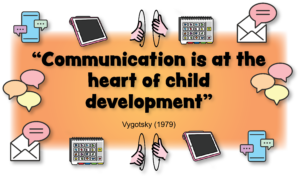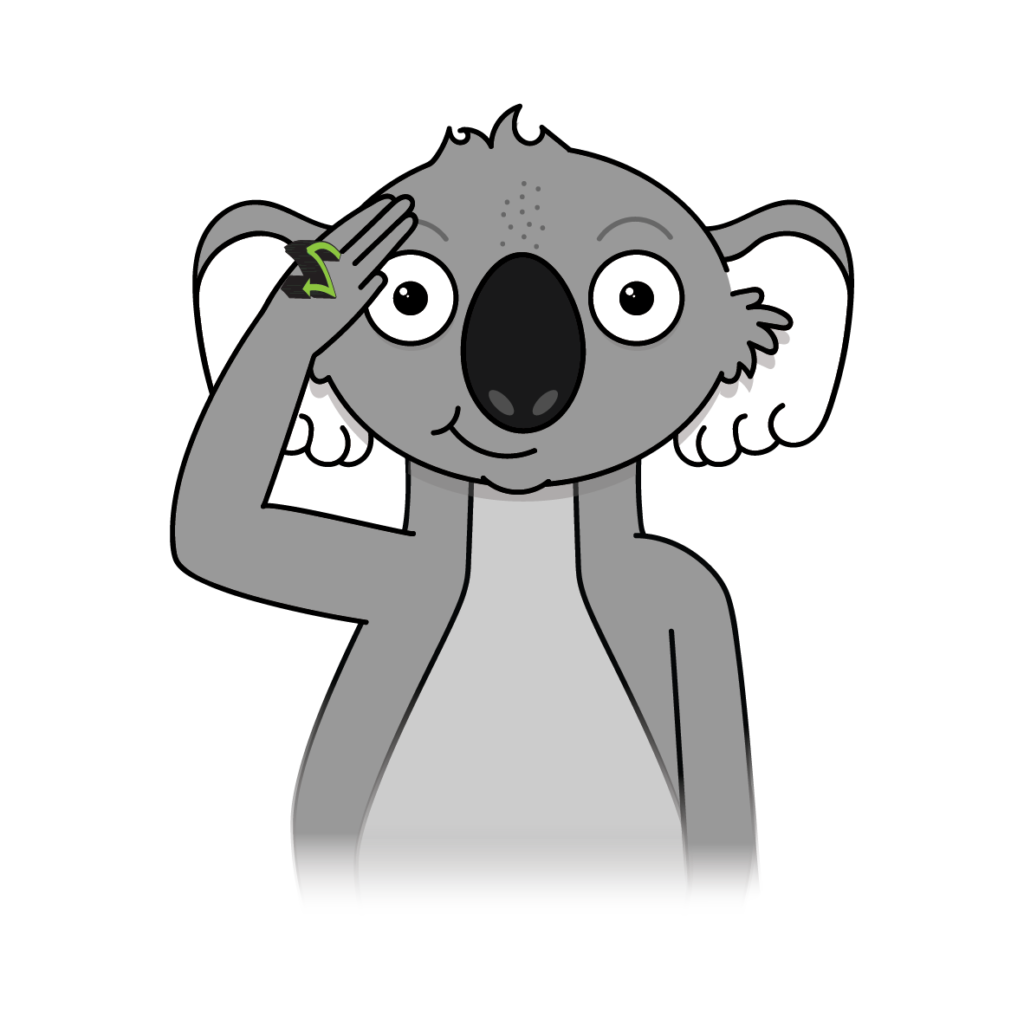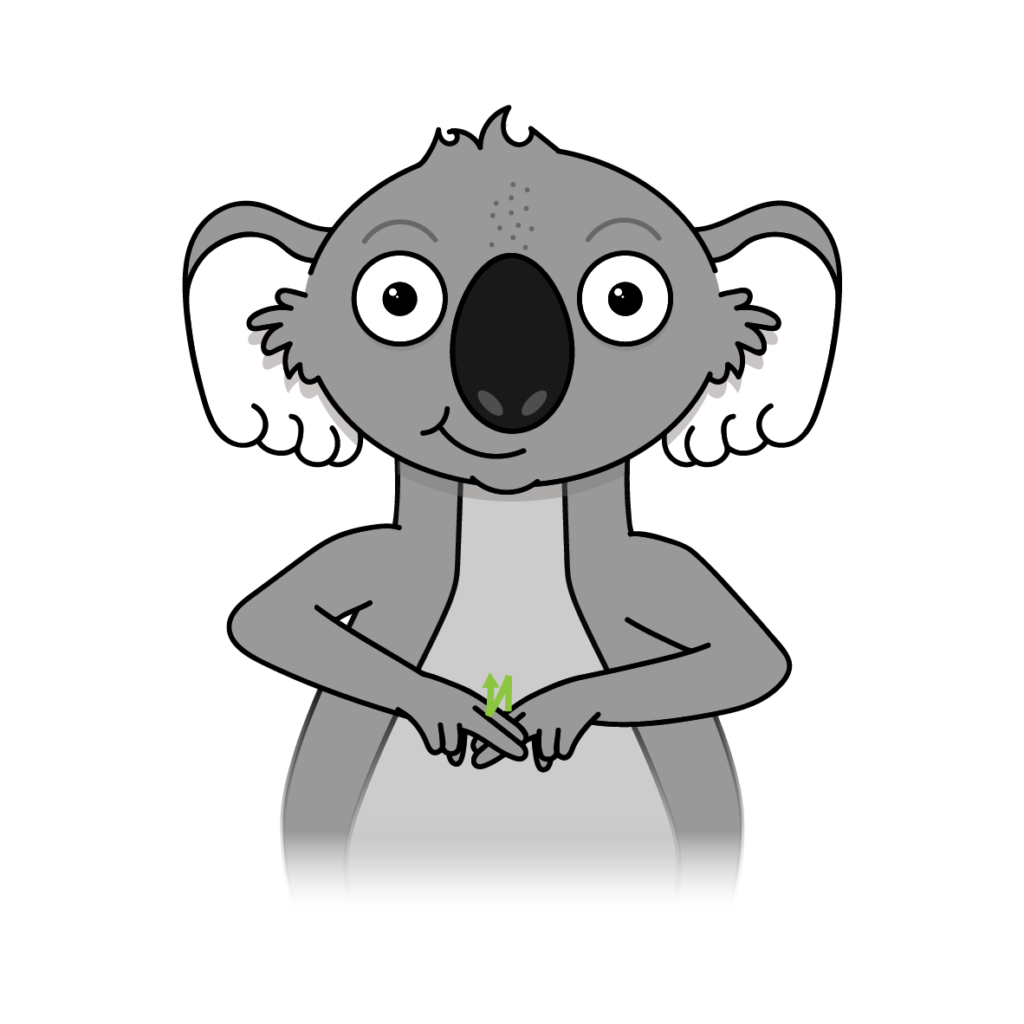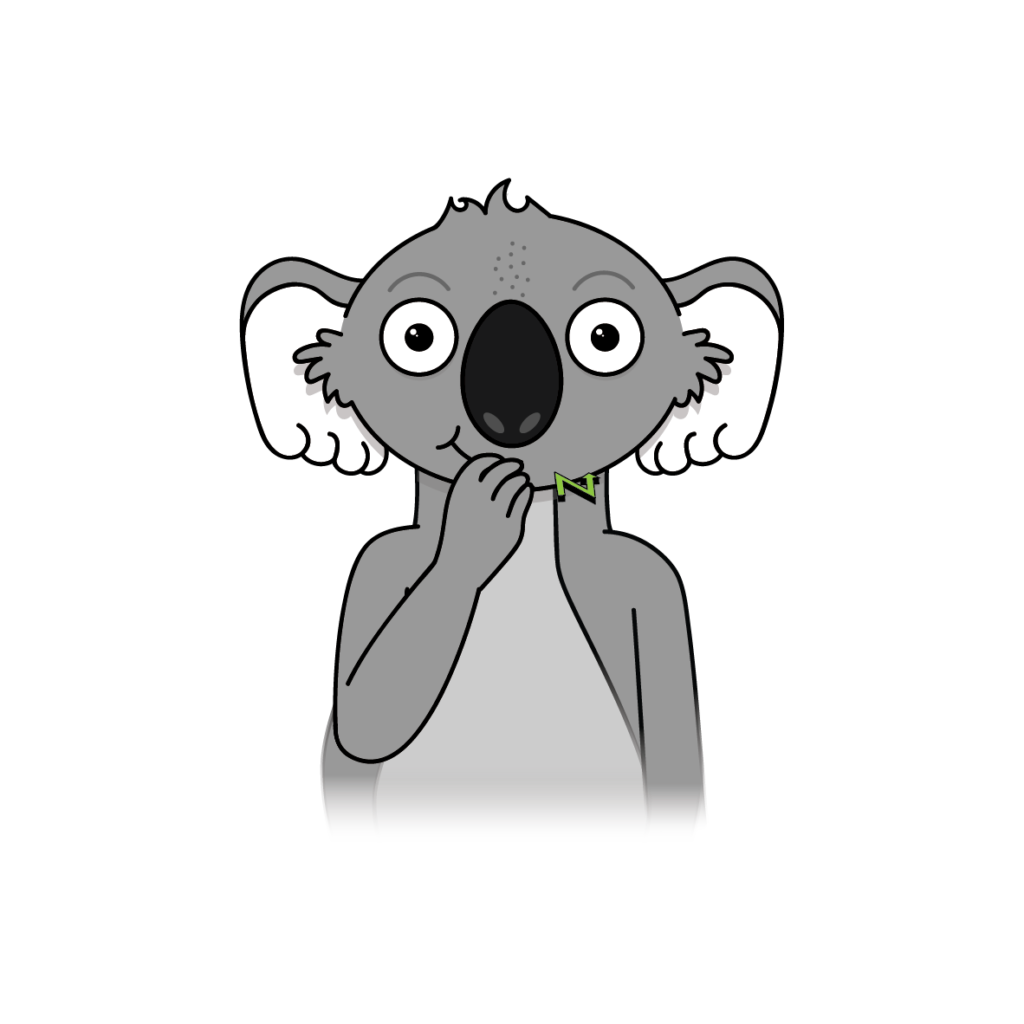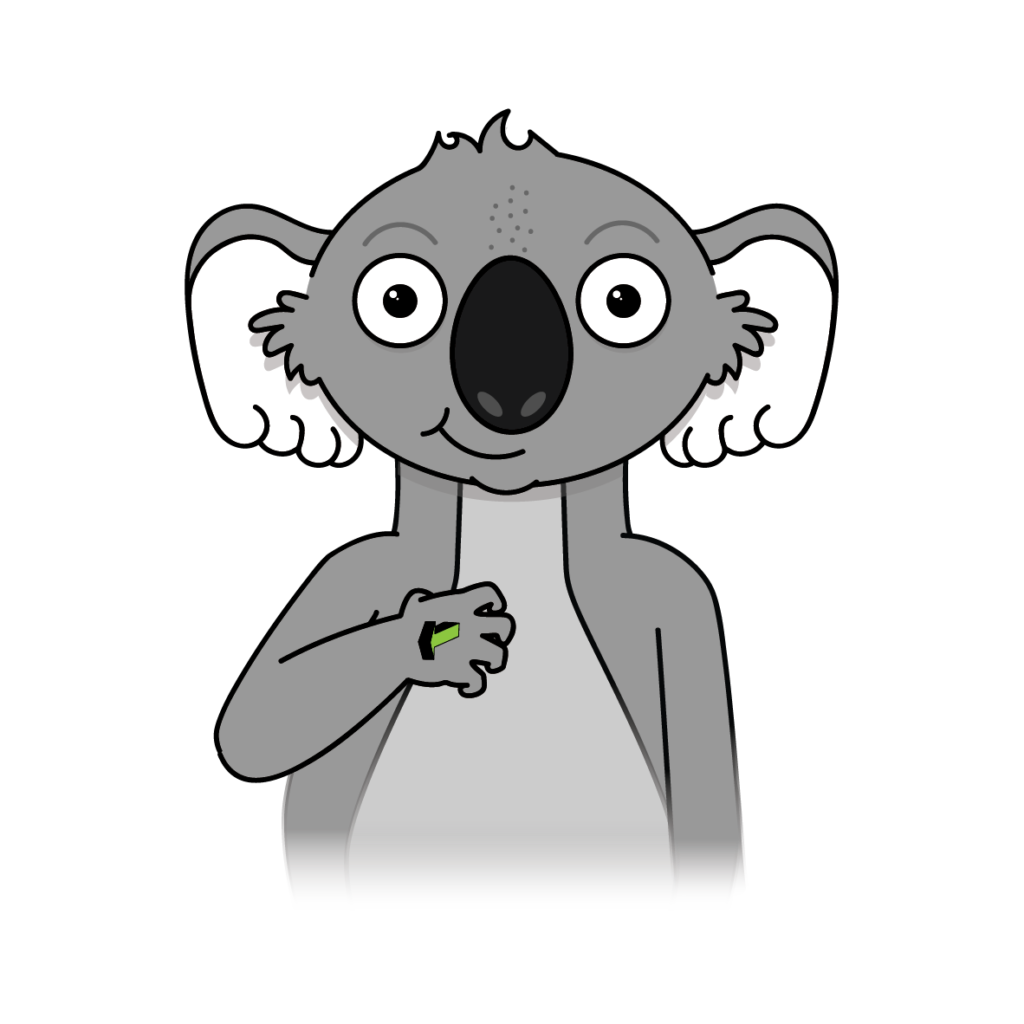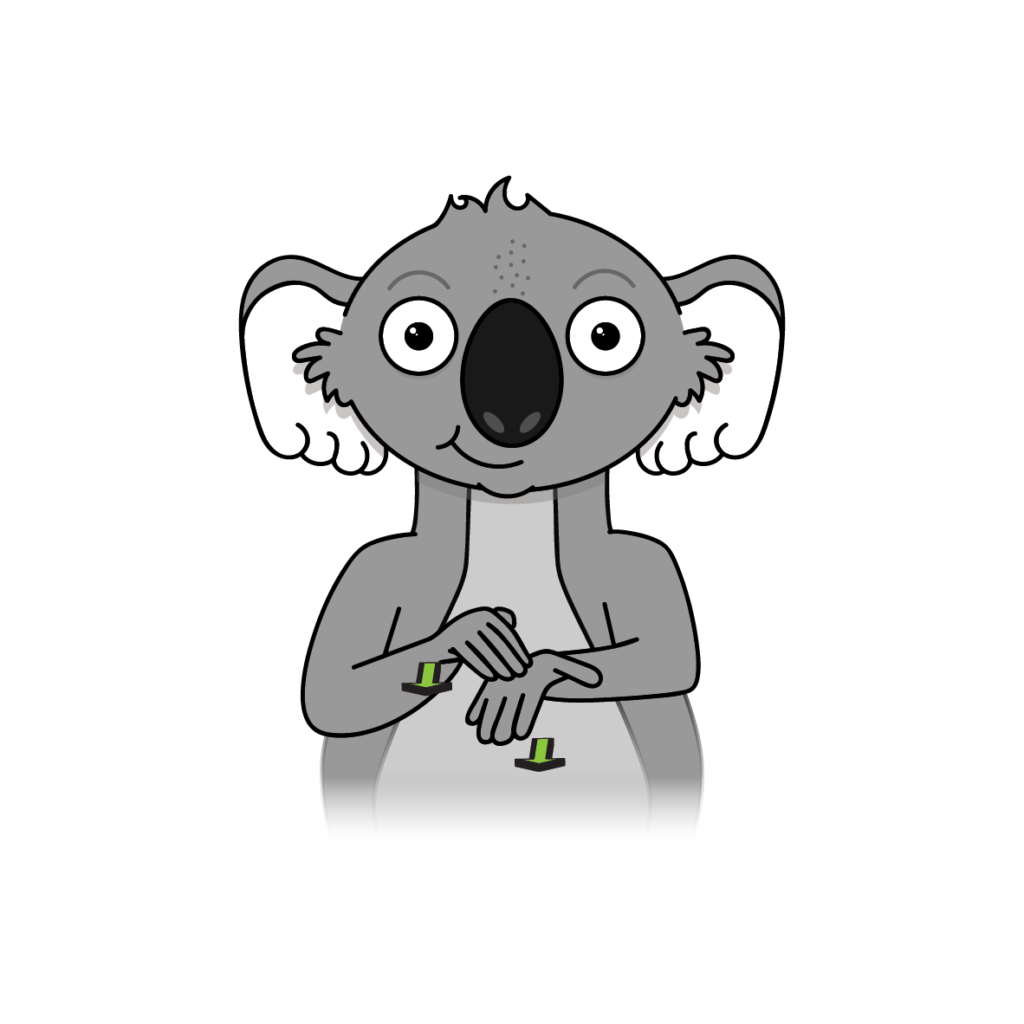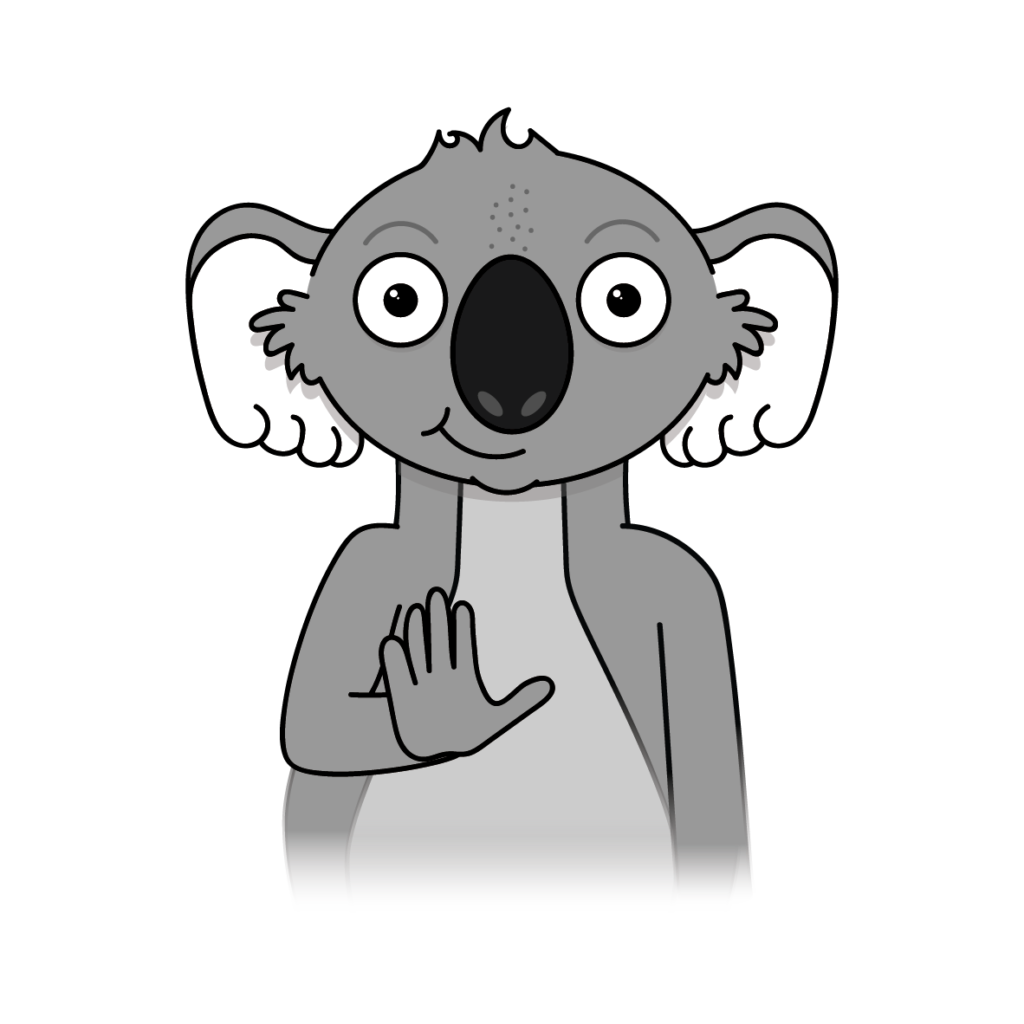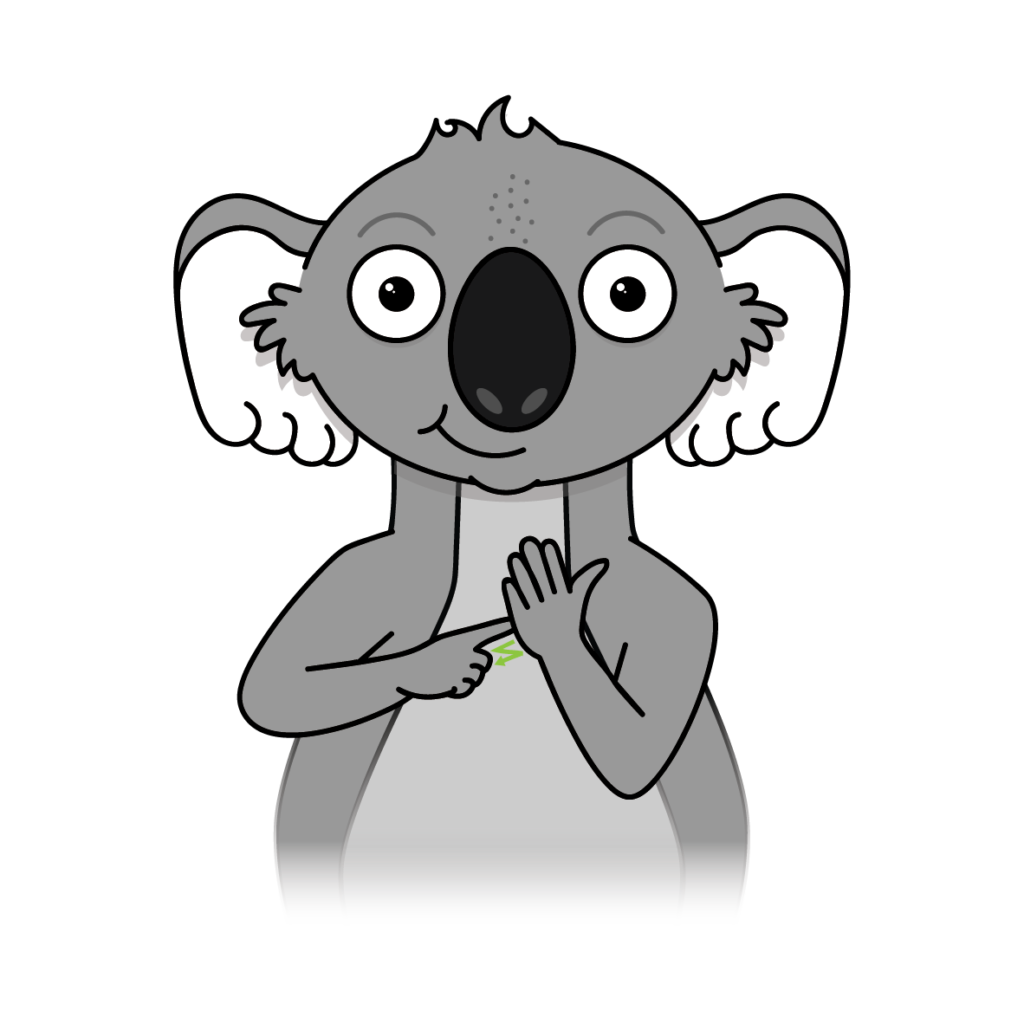FREE Key Word Signs (KWS) poster
Comprehensive Guide to Using the FREE Key Word Signs (KWS) poster in Daily Life
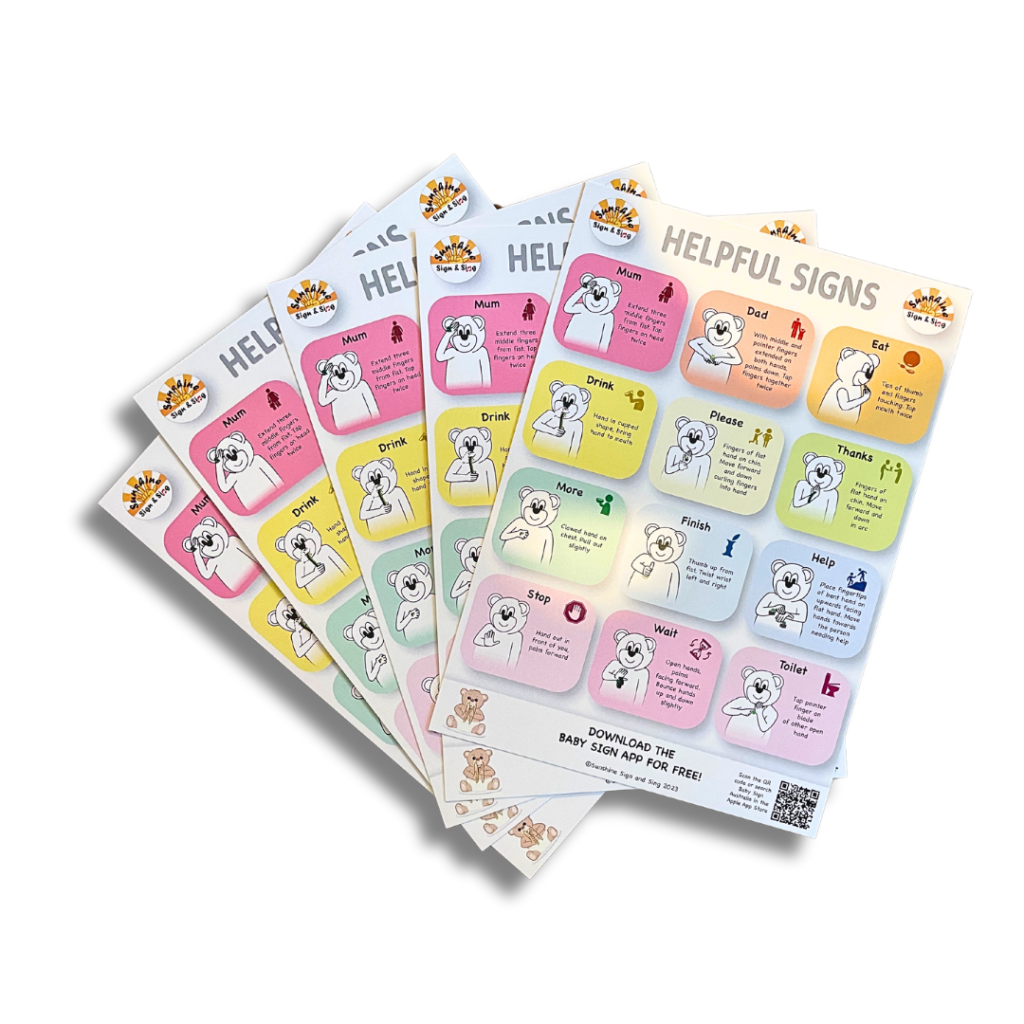
Thank you for downloading our FREE Key Word Sign poster. If you haven’t downloaded it yet, please click here to download.
Welcome to our in-depth guide on incorporating the key word signs on the poster into your child’s daily routines, storytime, and play activities. If you want more general information on getting started with using Key Word Sign please click here.
Whether you’re a parent, carer, teacher, or early years practitioner, this resource offers practical tips and creative ideas to support language development and enhance communication skills.
Key word signing is a valuable tool for children of all abilities, helping to bridge communication gaps and foster stronger connections. By consistently using these signs alongside speech, you’ll create an enriching environment that supports your child’s overall development. For more information on what key word sign is please click here.
In this guide, we’ll explore the 12 helpful Key Word Signs and provide numerous examples of how to seamlessly integrate them into various aspects of your child’s life. Let’s dive in and discover how these simple signs and gestures can make a world of difference!
Please note the symbols used on this page are board maker used with permission. PCS® by Tobii Dynavox® All rights reserved. Used with permission. PCS® and Boardmaker by Tobii Dynavox® All rights reserved. Used with permission.
Table of Contents
Click the pictures or words below to be taken to examples of how to implement the 12 common key word signs:
1. Mum
Please click the picture for a pop up video tutorial of how to sign Mum.
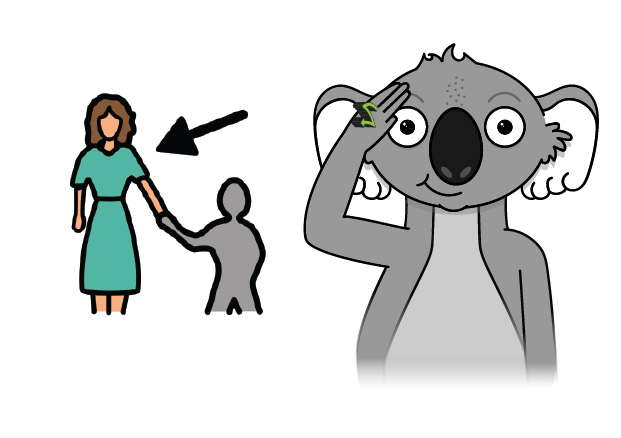
Routine
Using key word signs like “Mum” in daily routines supports language development, making it crucial for children, especially those with communication challenges.
When signs are integrated into everyday moments—such as saying “Good morning, Mum!” or “Look, Mum is here to pick you up!”—children repeatedly encounter the signs in context, which reinforces both their understanding and use. This consistent exposure through routine helps children associate the sign with its meaning, building a strong foundation for communication.
For children with communication disabilities, this approach is particularly effective because it links visual cues (signs) with spoken language. By embedding signs into familiar and comforting parts of their day, you provide an additional way for them to process language and express themselves. This natural, repetitive exposure reduces pressure and makes language learning feel effortless, supporting their communication journey and encouraging independence in a more inclusive way.
Book
When reading books featuring mothers, use the sign for “Mum” to make storytime more interactive and engaging.
Recommended Book: “My Mum” by Anthony Browne
Example:
“My Mum is fantastic. My Mum is magic.”
Alternatively you can purchase our ‘Sunny Bear’s Messy Day’ that incorporates first signs into the book. Click here to purchase your copy.
Song – Nursery Rhyme

Embedding the key word sign for “Mum” into songs and nursery rhymes offers a powerful way to enhance children’s language development.
Songs like Five Little Ducks provide a familiar structure, where the repetition of both lyrics and signs makes learning more engaging and memorable.
For example, during the verse:
“But only four little ducks came back. Mother duck said quack, quack, quack!”
You can introduce the sign for “Mum” when singing about mother duck. The combination of rhythm, lyrics, and gestures helps children associate the word “Mum” with its meaning, reinforcing both spoken language and the sign in a natural, playful context.
For children with communication challenges, embedding key word signs into songs is particularly effective. The repetition and predictability of nursery rhymes allow children to practise signs without feeling pressured, as the songs become a fun and familiar part of their routine. Incorporating signs into these enjoyable activities offers a multisensory approach to learning, combining music, movement, and visual cues to enhance understanding. Songs not only engage children’s attention but also make it easier for them to process and remember new words, offering an inclusive and accessible way to support communication development.
Play
Pretend play is a powerful tool for fostering overall language development, and embedding the key word sign for “Mum” into these activities makes it even more effective. Through role-playing with dolls, stuffed animals, or family scenarios, children have the opportunity to experiment with language in a low-pressure, creative environment. Using the sign for “Mum” during play helps them understand and internalise both the word and the gesture, reinforcing their ability to communicate in everyday situations.
For example, you might say:
“Is the baby looking for Mum?”
“Let’s pretend you’re the Mum getting ready to go to work.”
“Oh no, the kitten is crying for its Mum!”
These playful interactions build a child’s understanding of language and social roles, making it easier for them to transfer these concepts into real-life situations. Play encourages children to explore new vocabulary, sentence structures, and non-verbal communication, which is crucial for developing their overall language abilities. By incorporating key word signs, you’re offering an additional layer of support that helps children, particularly those with communication challenges, bridge the gap between spoken words and gestures, enhancing both their expressive and receptive language skills.
2. Dad
Please click the picture for a pop up video tutorial of how to sign Dad.

Routine
Using key word signs like “Dad” in daily routines enhances social connection, fostering a stronger bond between children and their caregivers. When children are encouraged to sign “Dad” during meaningful moments—like greeting Dad in the morning or asking, “Where’s Dad?”—they learn to communicate more intentionally, improving their understanding of relationships and social interactions.
By incorporating “Dad” into familiar routines, children develop a sense of security as they can easily identify and engage with significant people in their lives. This repetition strengthens their cognitive association between the sign, the word, and the person, which is essential for developing early social communication skills.
For children with communication challenges, the integration of signs into daily routines creates opportunities for non-verbal interaction. This supports their ability to express emotions and needs, empowering them to connect with their caregivers in a way that feels natural and supportive, building confidence and encouraging emotional development.
Examples:
“It’s time for Dad to read a bedtime story.”
“Dad will be home soon for dinner.”
“Let’s show Dad your new drawing.”
Book
Recommended Book: “My Dad” by Anthony Browne
Example:
“My Dad can eat like a horse and swim like a fish.”
When reading books featuring fathers, incorporating the sign for “Dad” adds a valuable visual component to the storytelling experience. Using key word signs during reading not only enhances comprehension but also reinforces language development. Research shows that the integration of signs alongside verbal language can significantly increase children’s understanding and retention of new vocabulary.
Using signs during reading fosters engagement and interaction. Children are more likely to participate and express themselves when they can physically demonstrate what they’re learning. This method not only enhances language skills but also encourages bonding moments between the reader and the child, making storytime a more enriching experience. Overall, incorporating key word signs while reading supports effective communication and lays a strong foundation for language development.
Alternatively you can purchase our ‘Sunny Bear’s Messy Day’ that incorporates first signs into the book. Click here to purchase your copy.
Song – Nursery Rhyme
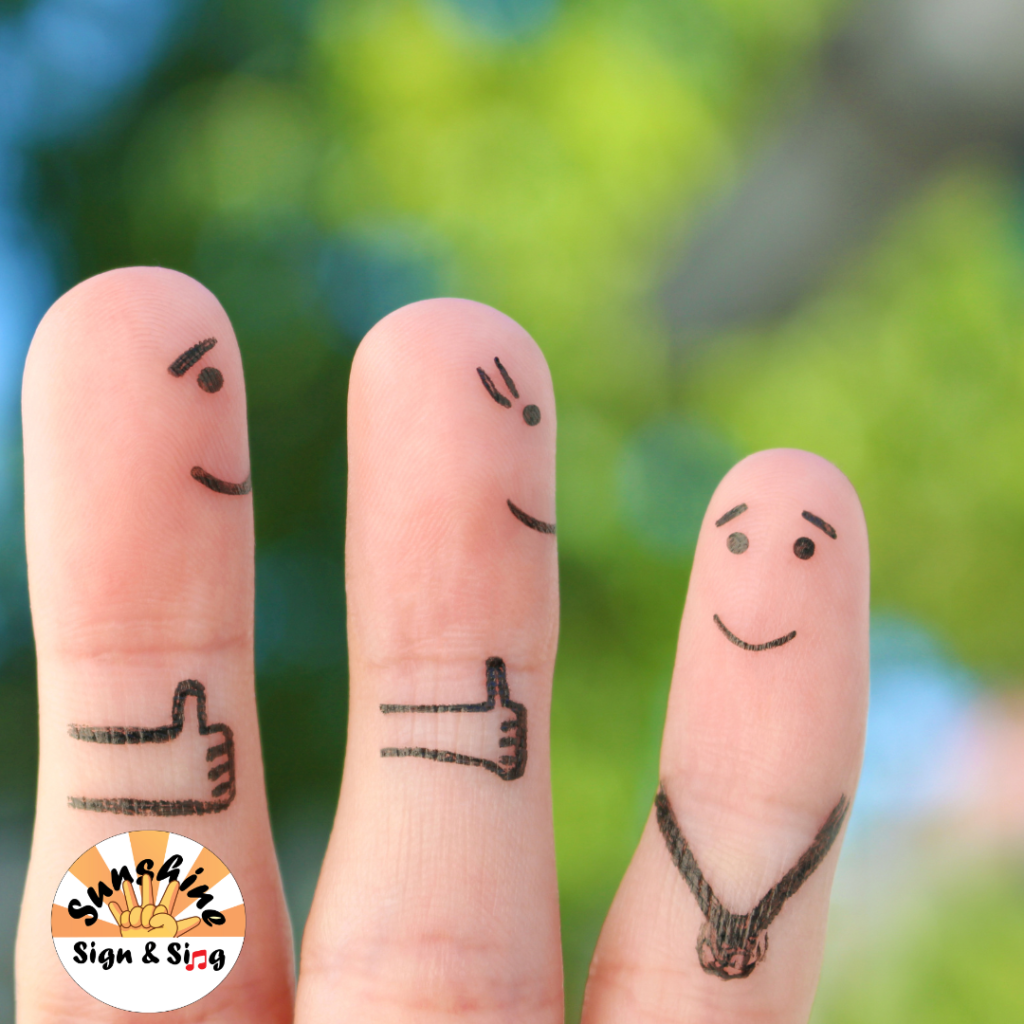
Songs like Daddy Finger provide a playful and repetitive structure that makes language learning enjoyable and memorable for children.
For example, while singing:
“Daddy finger, daddy finger where are you?”
You can introduce the sign for “Dad” when referring to the daddy finger. This combination of melody, gestures, and repetition helps children connect the word “Dad” to its meaning, strengthening their understanding in a natural and engaging way.
By integrating the sign for “Dad” into the song, you also create an opportunity for children to practise turn-taking. As they anticipate responses and follow the rhythm of the song, children learn how to wait for their turn, which is a key aspect of both communication and social interaction. This structured call-and-response format makes turn-taking feel fun and approachable, helping children develop important social skills.
Play
Pretend play is an excellent way to nurture children’s social and emotional development, and embedding the key word sign for “Dad” during these play scenarios deepens the experience. By role-playing family routines or imaginary scenarios with figures like dolls or action figures, children practise expressing emotions and social roles in a creative, low-pressure environment. Using the sign for “Dad” alongside verbal language helps them understand how to connect words with actions, making communication more intuitive.
For example, during parallel play, you might sit beside the child and describe what you see:
“Look, Dad is cooking dinner. What do you think he’s making?”
You can also encourage the child to take on the role of “Dad” with open-ended questions:
“How would Dad fix the car?”
“What does Dad do when he comes home from work?”
These types of questions encourage children to think more deeply and use their imagination, fostering critical thinking and conversation skills. Play scenarios involving “Dad” help children explore family dynamics and everyday life while allowing them to practise new vocabulary and sentence structures.
For children with communication challenges, using key word signs like “Dad” during pretend play helps bridge the gap between spoken language and gestures. It provides visual and physical cues that support their understanding of language, while parallel play allows them to absorb language naturally in a shared, non-pressured setting. This holistic approach encourages language exploration, creativity, and confidence in communication.
3. Eat
Please click on the images for pop up tutorials of the key word signs.
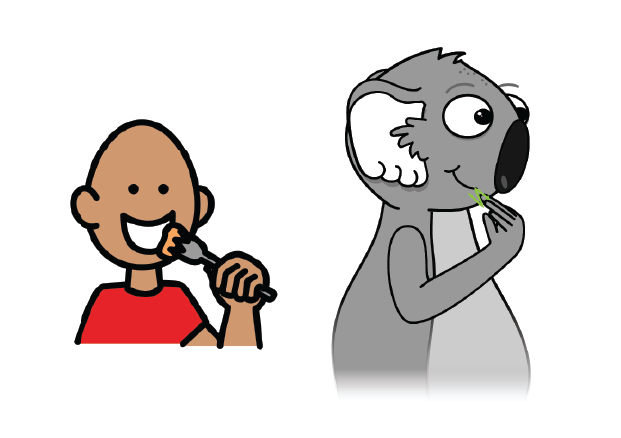
Routine
Incorporating the sign for “eat” into everyday interactions during meals provides a powerful opportunity to support children’s understanding of cause and effect, which is essential for cognitive development.
When children consistently see and use the sign for “eat” during meals or snacks, they begin to connect the gesture not only with the act of eating but also with the concept of hunger and satisfying that need. This helps children develop an awareness of their body’s signals and how communication can lead to fulfilling those needs.
Examples:
- “Are you feeling hungry? It’s time to eat.”
- “Let’s eat dinner together!”
- “After we eat, we can go play.”
By embedding the sign for “eat” in natural, everyday moments, children gradually build an understanding of how language and actions can influence their environment. This connection to cause and effect is particularly important for young children as it helps them learn how to express their needs more effectively, promoting greater independence and self-awareness. Additionally, for children with communication challenges, the consistent use of the sign provides a clear and structured way for them to express their needs without frustration.
Book
Recommended Book: “The Very Hungry Caterpillar” by Eric Carle
Example: “On Monday, he ate through one apple. But he was still hungry.”
Reading with children offers numerous benefits, one of which is fostering a love for stories and books. This shared experience not only enhances their language skills by introducing new vocabulary but also sparks their imagination and creativity.
When you incorporate the sign for “eat” while reading about food, such as in The Very Hungry Caterpillar, you reinforce the connection between the word and its meaning. For example, saying, “On Monday, he [sign] ate through one apple. But he was still hungry,” helps children associate the sign with the action, enhancing their understanding.
This engagement not only helps with vocabulary acquisition but also encourages critical listening skills and promotes a deeper connection to the story. By embedding signs into reading time, you create a multisensory experience that makes learning more interactive and enjoyable. Additionally, this nurturing environment strengthens your bond, providing a comforting space for discussions about the story, emotions, and ideas. Overall, reading with children lays a strong foundation for lifelong literacy and learning while supporting their communication skills.
Song – Nursery Rhyme

Recommended Song: Little Miss Muffet
Lyrics:
“Little Miss Muffet sat on her tuffet, eating her curds and whey.
Along came a spider, who sat down beside her,
And frightened Miss Muffet away.”
When incorporating the sign for “eat” into songs, a significant benefit is the enhancement of cognitive skills. Using Little Miss Muffet allows children to engage their memory and attention while following along with both the lyrics and the signs.
By singing the lyrics and introducing the sign for “eat,” children are required to recall both the words and the associated gestures, improving their working memory. This interaction helps them learn to sequence events and concepts, as they understand the narrative of Miss Muffet and her food. This cognitive challenge supports their ability to organise information and think critically about the content.
Additionally, this approach makes learning enjoyable and interactive, as children are likely to remember the signs and lyrics through the rhythm and context of the song. Integrating key word signs into familiar tunes like Little Miss Muffet not only reinforces language learning but also stimulates cognitive development in a fun and engaging way.
Play
Engaging in pretend kitchen play, tea parties, or restaurant role-play provides children with an excellent opportunity to develop their social skills while incorporating the sign for “eat.” This type of imaginative play allows children to explore language and communication in a fun and supportive environment.
By using the sign for “eat” during these activities, you can promote turn-taking and encourage children to express their preferences and desires. For example:
“Would you like to eat some pizza?”
“The teddy bears are hungry. Let’s eat a picnic lunch with them.”
“In our restaurant, we need to ask customers what they want to eat.”
This playful interaction fosters cooperation and negotiation skills, as children learn to collaborate and communicate effectively with their peers. By integrating key word signs, you enhance their ability to articulate thoughts and feelings, empowering them to express themselves more confidently in social situations.
Additionally, these role-play scenarios help children practice conversational skills and expand their vocabulary in context. As they engage in dialogue about food and eating, they become more comfortable using language in various settings, further supporting their overall communication development. This blend of social interaction and language practice makes pretend play a powerful tool for nurturing children’s growth and self-expression.
4. Drink
Please click the picture for a pop up video tutorial of how to sign drink.
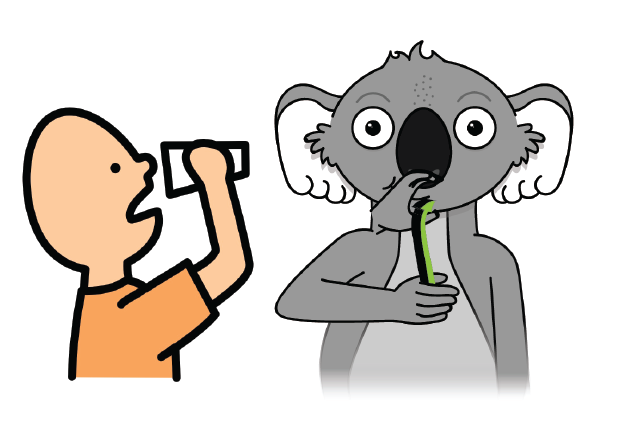
Routine
Incorporating the sign for “drink” into everyday interactions is a practical and effective way to enhance children’s communication skills. By regularly using this sign during moments involving beverages, children learn to associate the gesture with the action of drinking, reinforcing their understanding of this basic need.
For instance, you can integrate the sign for “drink” during routine moments, such as:
- Offering a drink: “Would you like a drink of water?”
- Responding to thirst: “It’s hot outside. Let’s drink some cool lemonade.”
- Encouraging bedtime routines: “Time to drink your milk before bed.”
By embedding the sign in these familiar contexts, children gradually become more aware of their thirst cues and learn how to communicate their needs effectively. This consistent exposure helps them develop an understanding of the relationship between their body’s signals and their ability to express those needs verbally or through signs.
Additionally, using the sign for “drink” in daily interactions fosters a sense of independence. As children begin to grasp the concept that they can communicate their thirst, they feel empowered to ask for what they need. This not only supports their language development but also encourages them to take an active role in caring for their own basic needs, promoting self-awareness and confidence. For children with communication challenges, incorporating signs like “drink” provides a clear and structured way to express their needs, creating a more inclusive environment where they can participate fully in everyday activities.
Book
Recommended Book: The Tiger Who Came to Tea by Judith Kerr
Example: “So Sophie’s Mummy said, “ Would you like a drink?””
Incorporating the sign for “drink” while reading books that feature beverages is an engaging way to reinforce the concept of hydration and encourage communication. When children see and use the sign during these stories, they make a clear connection between the sign, the action of drinking, and its context within the narrative.
By consistently integrating the sign for “drink” in the context of familiar stories, children not only enhance their understanding of the word but also develop their vocabulary in a meaningful way. For example, as you read the passage about the tiger drinking, you can emphasise the sign, making it a memorable part of the experience.
This approach not only makes reading more interactive but also helps children recognise the importance of communicating their thirst. It promotes an understanding of hydration as a basic need, encouraging children to express when they want a drink. This simple yet effective practice supports language development and fosters independence in recognising and articulating their needs, making it particularly beneficial for children with communication challenges.
Song – Nursery Rhyme
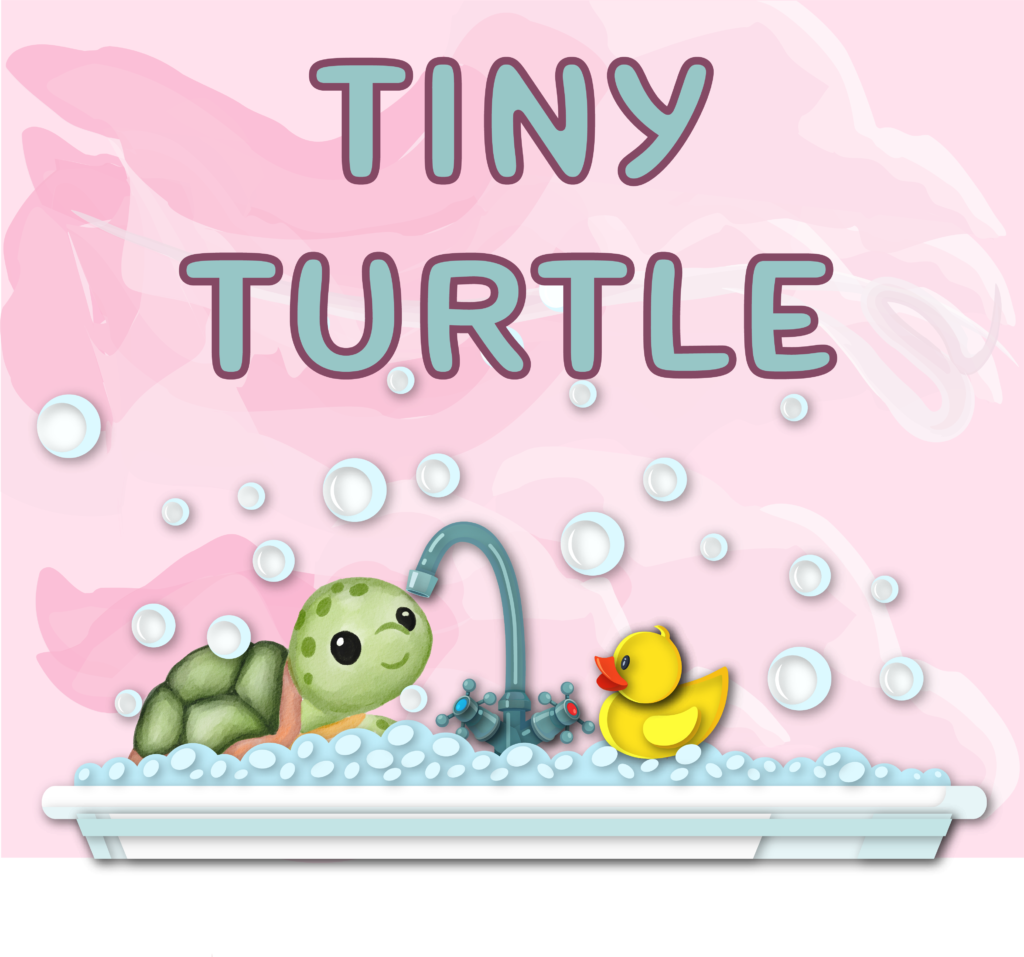
Include the sign for “drink” in songs or rhymes about beverages or drinking.
Recommended Song: “I had a little turtle”
Recommended Song: I Had a Little Turtle
Lyrics:
“I had a little turtle, his name was Tiny Tim.
I put him in the bathtub, to see if he could swim.
He drank up all the water, he ate up all the soap.
And now he’s sick in bed with a bubble in his throat.”
When incorporating the sign for “drink” into this song, a significant benefit is the enhancement of motor skills:
Integrating the sign for “drink” into “I Had a Little Turtle” provides an excellent opportunity for children to develop and refine their motor skills. The act of performing the sign requires precise hand movements, which can help improve fine motor control and hand-eye coordination.
As children make the “drink” sign – typically bringing a cupped hand to the mouth – they practice controlling small muscle movements in their fingers, hands, and wrists. This repetitive motion, performed in rhythm with the song, helps strengthen the muscles used for fine motor tasks.
Moreover, coordinating the hand movement with the specific word in the lyrics enhances timing and rhythm skills. Children must synchronize their physical actions with the auditory cues from the song, which promotes better motor planning and sequencing abilities.
The regularity of practicing this sign within the context of a familiar, enjoyable song allows for repeated, natural practice. This repetition is key to motor skill development, as it helps build muscle memory and increases the fluidity and accuracy of the movement over time.
By focusing on motor skills through signing while singing, children engage in a fun, multisensory activity that supports their physical development in an engaging and memorable way.
Play
Engaging in pretend play involving beverages, such as tea parties, juice stands, or café role-play, offers children another rich opportunity to develop their social and communication skills. By incorporating the sign for “drink” during these imaginative scenarios, children not only expand their vocabulary but also learn to engage in meaningful dialogue with peers and adults.
Encouraging the use of the “drink” sign during role-play enhances turn-taking, helps children articulate their desires, and promotes interaction. For example:
- “Let’s have a tea party and drink from our cups.”
- “The baby doll is thirsty. Can you give her a drink?”
- “In our café, we need to ask our customers what they’d like to drink.”
These simple, playful prompts allow children to express preferences while learning how to navigate social conversations. This type of interaction naturally fosters cooperation and collaboration as children learn to listen, respond, and adjust their behaviour based on social cues.
5. Please
Please click on the images for pop up tutorials of the key word signs.
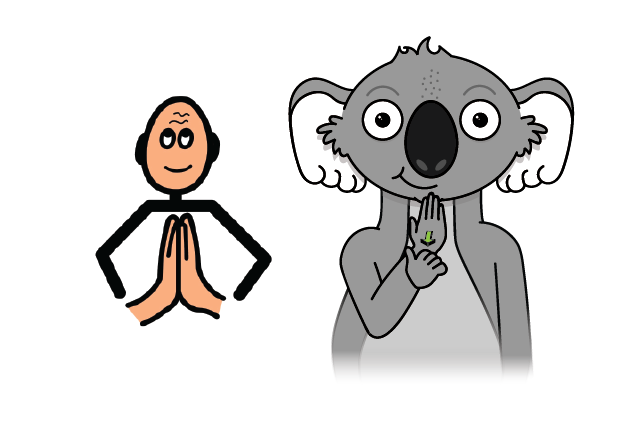
Routine
Modeling polite behaviour by signing “please” when making requests or responding to your child’s requests is a great way to introduce social niceties while also reinforcing functional communication. By using signs like “please” during everyday interactions, children learn not only to communicate effectively but also to navigate social conventions in a respectful manner.
For example:
- “Can I have more cereal, please?”
- “Please put your toys away.”
- “Please would you like to help me set the table?”
Incorporating polite expressions such as “please” into your communication routines can help children understand the importance of kindness and respect in their interactions. However, it’s important to remember that while teaching politeness is valuable, the primary focus should be on functional language, particularly for children who have limited language skills.
Understanding Functional Language
Functional language refers to words or signs that help children communicate their most basic needs and wants, such as “eat,” “drink,” “more,” or “help.” These words are essential for facilitating independence and ensuring that a child can communicate effectively in their daily environment. For children who are in the early stages of language development, teaching functional signs that allow them to express their immediate needs is far more important than focusing on social conventions like “please” or “thank you.”
For example, if a child is struggling with communication and only has a few key words or signs in their repertoire, focusing on core vocabulary that directly impacts their ability to interact meaningfully with the world—like “more,” “finished,” or “help”—should take priority. Once the child is able to express these fundamental needs and can engage in simple back-and-forth communication, then signs for social etiquette, such as “please” and “thank you,” can be introduced.
When to Introduce “Please” and “Thank You”
If a child has very limited language or is just beginning to use key word signs, the focus should remain on practical communication rather than politeness. While teaching manners is important, children first need to feel empowered to communicate their basic wants and needs. Polite language can be gradually introduced as they become more confident in their use of functional language.
For example:
- If a child is learning the sign for “help,” it’s more important that they can consistently use “help” to get assistance than to add “please” at this stage.
- When teaching “more,” ensuring that the child can use it to express their needs during mealtimes or play is key before introducing “please.”
Once functional signs are firmly established and the child is using them regularly to communicate, social phrases like “please” and “thank you” can be layered on, helping children expand their social awareness while still ensuring their core communication needs are met.
Polite Language in Context
For children who are further along in their language development, modeling “please” and “thank you” key word signs in daily routines helps foster positive social behaviours. For example, when asking your child to share toys or requesting their help with a task, you can sign “please” to show them how polite communication works:
- “Please hand me the ball.”
- “You did such a great job! Thank you!”
This shows them how to communicate respectfully while continuing to focus on functional communication as the foundation of language development.
Ultimately, balancing functional communication with polite language helps children build meaningful connections, understand social expectations, and become confident communicators.
Book
Choose books that emphasise good manners and use the sign for “please” when appropriate.
Recommended Book: “The Berenstain Bears Say Please and Thank You” by Mike Berenstain
Example:
- “Brother Bear learned to say please when asking for something.”
Song – Nursery Rhyme
Incorporate the sign for “please” into songs or rhymes about manners.
Recommended Song: “Please & Thank You – Full Song – Doggyland Kids Songs & Nursery Rhymes by Snoop Dogg
Lyrics with Sign: “Please and thank you, Please and thank you, It’s what we say, It’s what we say, We don’t want to be rude, We say please and thank you, Every day, Every day.”
Please also be aware many please and thank you song on you tube use American Sign Language (ASL), make sure if you choose a video with signs that they are Australian Key Word Signs or Auslan.
Play
In games or when taking turns, use the sign for “please” to encourage polite interactions.
Examples:
- “Please can I have a turn with the blue car?”
- “When playing shop, try to say please when asking for items.”
- “In our restaurant, try to say please when ordering food.”
6. Thank You
Please click on the images for pop up tutorials of the key word signs.

Routine
Show gratitude by signing “thank you” during daily interactions, especially after your child helps or gives something.
Examples:
- “Thank you for helping me tidy up.”
- “Let’s say thank you to Grandma for the lovely gift.”
- “Thank you for sharing your toys with your friend.”
Book
Choose books that emphasise gratitude and use the sign for “thank you” when appropriate.
Recommended Book: “The Thank You Book” by Mo Willems
Example:
- “Piggie wants to say thank you to everyone!”
Please see above for information on when to introduce niceties such as please and thank you.
Song – Nursery Rhyme
Incorporate the sign for “thank you” into songs or rhymes about manners.
Recommended Song: “Please & Thank You – Full Song – Doggyland Kids Songs & Nursery Rhymes by Snoop Dogg
Lyrics with Sign: “Please and thank you, Please and thank you, It’s what we say, It’s what we say, We don’t want to be rude, We say please and thank you, Every day, Every day.”
Please also be aware many please and thank you song on you tube use American Sign Language (ASL), make sure if you choose a video with signs that they are Australian Key Word Signs or Auslan.
Play
During pretend play scenarios, encourage the use of “thank you” after each pretend interaction.
Examples:
- “After the doctor helps you, say thank you.”
- “The teddy said thank you to the dolly for sharing their toys.”
- “In our post office, we say thank you when you receive your parcel.”
7. More
Please click on the images for pop up tutorials of the key word signs.
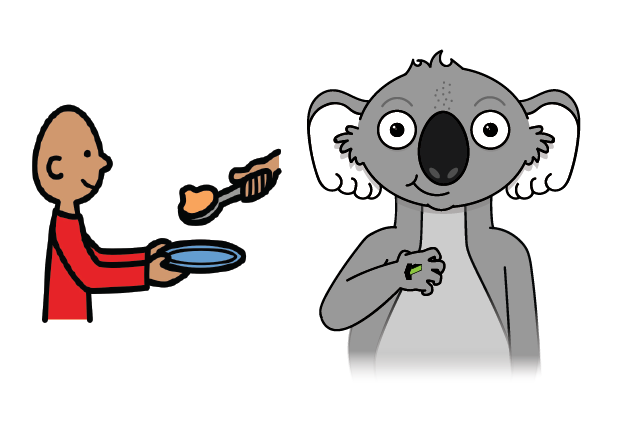
Routine
Use the sign for “more” when offering food, activities, or anything that can be repeated.
Examples:
- “Would you like more porridge?”
- “Shall we read more stories before bed?”
- “Do you want more bubbles in your bath?”
For children who are non-speaking or have communication challenges, the key word sign for “more” is especially versatile because it can be applied in a wide variety of situations. Whether it’s asking for more food, another turn at a game, or to continue an activity, “more” gives children a powerful tool to express their desires, reducing frustration and promoting independence. The simplicity and flexibility of the sign make it one of the most practical for early communication, offering an accessible way for children to engage with their environment and interact with others.
By integrating “more” into familiar parts of the day, you’re helping children learn language naturally, at their own pace, while also providing them with a sense of control over their interactions. This approach fosters confidence, making language learning a more inclusive and supportive experience for all children.
Book
Choose books with repetitive phrases or actions and use the sign for “more” when appropriate.
Recommended Book: “More, More, More” by Dawn Casey 2011
Example:
- “And the whale went more, more, MORE!”
Song – Nursery Rhyme
Incorporate the sign for “more” into songs or rhymes, especially those with repetitive verses.
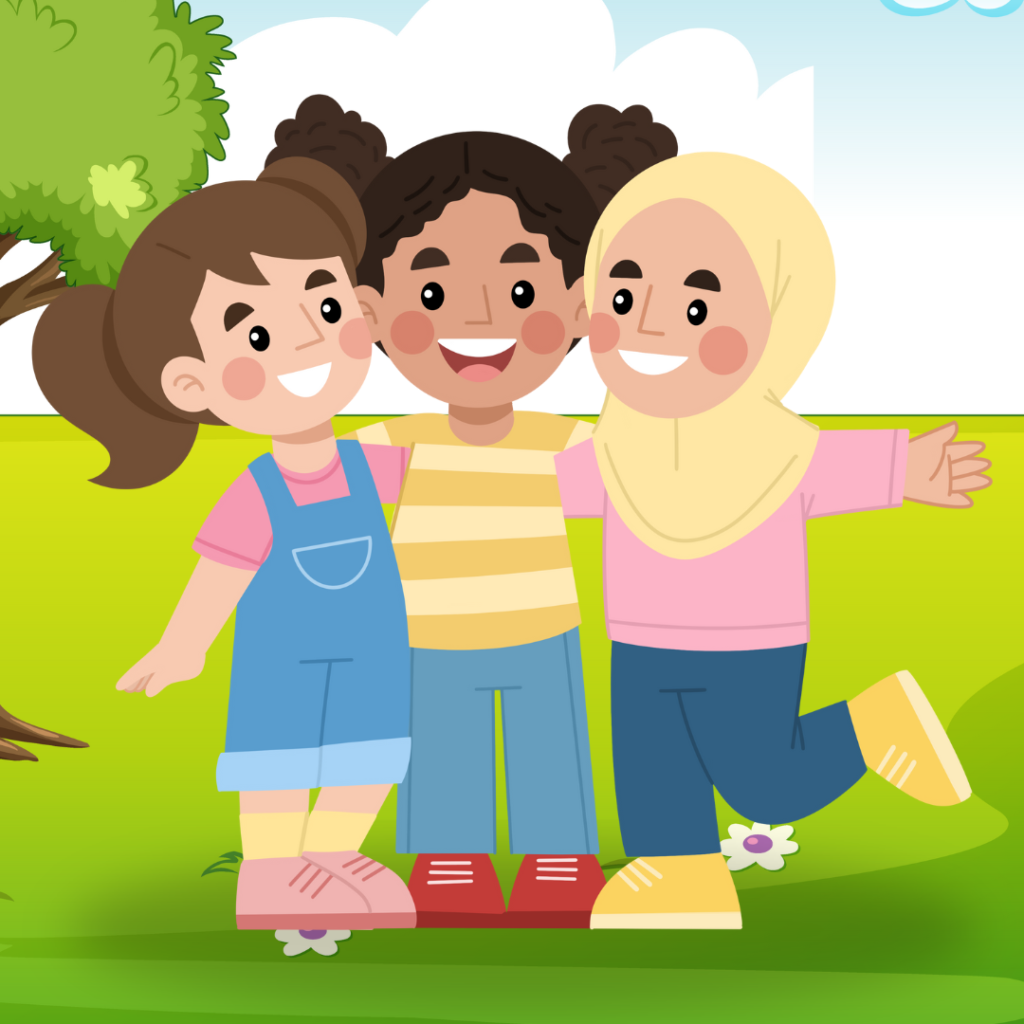
Recommended Song: “The more we get together”
Lyrics: “The more we get together,Together, together,The more we get together,The happier we’ll be.For your friends are my friends, And my friends are your friends.The more we get together,The happier we’ll be.”
Adding key word signs to songs like “The More We Get Together” enhances children’s focus. The combination of following along with both the lyrics and the signs requires them to engage more deeply, improving their attention and concentration. This increased focus not only helps with language retention but can also positively impact their ability to concentrate in other learning activities.
Play
In building activities, sensory play, or any repetitive games, encourage the use of the sign when your child wants to continue.
Examples:
- “Do you want more blocks for your tower?”
- “Shall we make more playdough shapes?”
- “Would you like more time on the swings?”
8. Finished
Please click on the images for pop up tutorials of the key word signs.
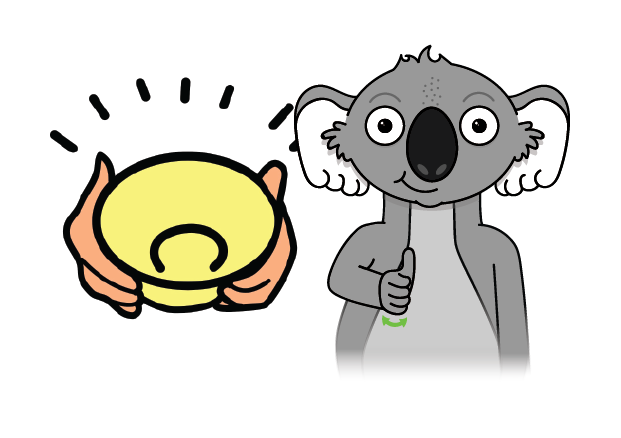
Routine
Use the sign for “finished” at the end of meals, activities, or tasks to help your child learn how to communicate completion.
Examples:
- “Are you finished with your lunch?”
- “We’re finished with our walk. Time to go home!”
- “When you’re finished brushing your teeth, let me know.”
Book
Use the key word sign for “finished” when closing a book or completing each page.
Recommended Book: “Let me Finish” by Minh Le
Example:
- “Next time, please let me finish.”
Song – Nursery Rhyme
Incorporate the sign for “finished” into songs or rhymes, especially at the end.
Recommended Song: “To market, to market to buy a penny bun”
Lyrics with Sign: “To market, to market, to buy a fat pig,Home again, home again, jiggety-jig.To market, to market, to buy a fat hog, Home again, home again, jiggety-jog. To market, to market to buy a plum cake,Home again, home again, market is late.To market, to market, to buy a plum bun,Home again, home again, market is done.To market, to market to buy a fat dog,Home again, home again, jiggety jog.To market, to market to buy a small chick,Home again, home again, jiggety jig.”
This song can be adapted to include “done” or finished more to the song.
As well as the word being used in the song the word ‘finish’ can be used during song time. For example you could sing a simple song about everyday routines and use “finish” as the cue for when the activity ends. For example, during clean-up time:
“Now we’re picking up the toys, picking up the toys,
Now we’re finished picking up, let’s move on!”
This not only helps children understand that they’ve completed the task, but also teaches them to expect what comes next. It’s especially helpful during transitions between activities in classroom settings or at home.
You can also use “finish” in songs for games or activities that have a clear endpoint. For instance, during musical chairs or when transitioning from one game to another, singing:
“Now we’re finished playing this game,
It’s time for something new!”
Songs like these help children with the structure of beginning and ending tasks, making transitions smoother. For children with communication challenges, using the sign for “finish” within these contexts can empower them to express when they’re done, making it a functional and versatile word that integrates seamlessly into both structured and spontaneous learning moments.
Play
During play, you can use the key word sign for “finished” to signal the completion of individual steps or actions within the activity itself, reinforcing the concept of finishing throughout the game or task.
For example, during water play:
- Pouring water: “Look, the cup is full! Now we’re finished pouring. Let’s pour again!”
- Building blocks: “This tower is getting tall. When we’re finished, we can knock it down!”
- Pretend cooking: “We’re finished mixing the ingredients. Now let’s put it in the oven!”
By using the sign for “finished” during these moments, you create opportunities for children to recognise the completion of steps in a process, rather than just signalling the end of the entire activity. This approach enhances their understanding of sequences and helps develop both their language and cognitive skills. It’s also especially useful for children who thrive on structure, as it gives them a clear sense of progression within the play.
Further, during cleanup after play or at the end of a game, use the sign for “finished” to signal the end of the activity.
Examples:
• “We’re finished with playtime. Let’s tidy up!”
• “The puzzle is finished. Great job!”
•”When you’re finished with your painting, we can hang it up to dry.”
9. Help
Please click on the images for pop up tutorials of the key word signs.
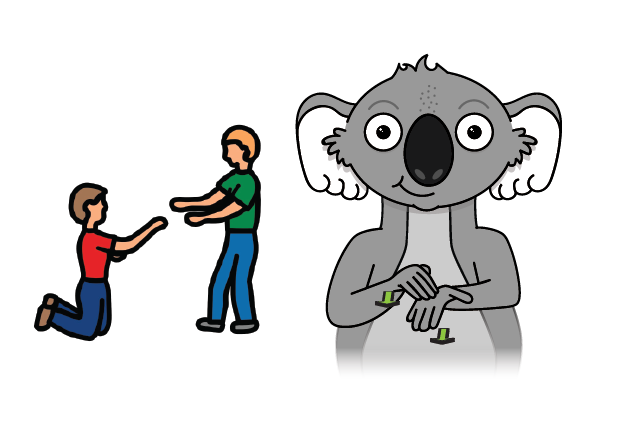
Routine
Like many core words the key word sign for “help” is incredibly versatile, making it a valuable addition to a child’s communication toolkit.
Its broad applicability spans various situations and contexts, from physical tasks like reaching objects to cognitive challenges such as solving puzzles, and even emotional support when dealing with frustration.
This versatility allows the sign to be useful in different environments – at home, school, or public places – and adaptable to various levels of need, from minor assistance to more significant support.
The sign grows with the child, initially used for basic needs and later applied to more complex situations. It facilitates interaction with different people, including family, teachers, peers, and even strangers in emergencies. Moreover, it can be combined with other signs or words, further expanding its utility. This multifaceted nature means that once learned, the sign for “help” becomes a powerful tool that remains useful well beyond early childhood, supporting a child’s communication skills as they develop.
Encourage independence by using the sign for “help” when your child needs assistance with daily tasks.
Examples:
- “Do you need help with your shoes?”
- “Let me help you reach the cereal box.”
- “If you need help with your homework, just ask.”
Book
Choose books where characters help each other and use the key word sign for “help” when appropriate.
Recommended Book: “Help! I really mean it!” by Lauren Child
Example:
- “Sorry Charlie we only said help by accident.”
During story time, you can extend the use of the key word sign “help” beyond just reading the words on the page. For instance:
- Before turning the page, ask “Can you help me turn the page?”
- When discussing the story, inquire “How did the character help their friend?”
- If the book has interactive elements, say “Let’s help the character find the hidden object.”
- When the story is finished, suggest “Can you help me put the book back on the shelf?”
These additional interactions create more opportunities to practice the sign and reinforce its meaning in various contexts, making story time both educational and engaging.
Song – Nursery Rhyme
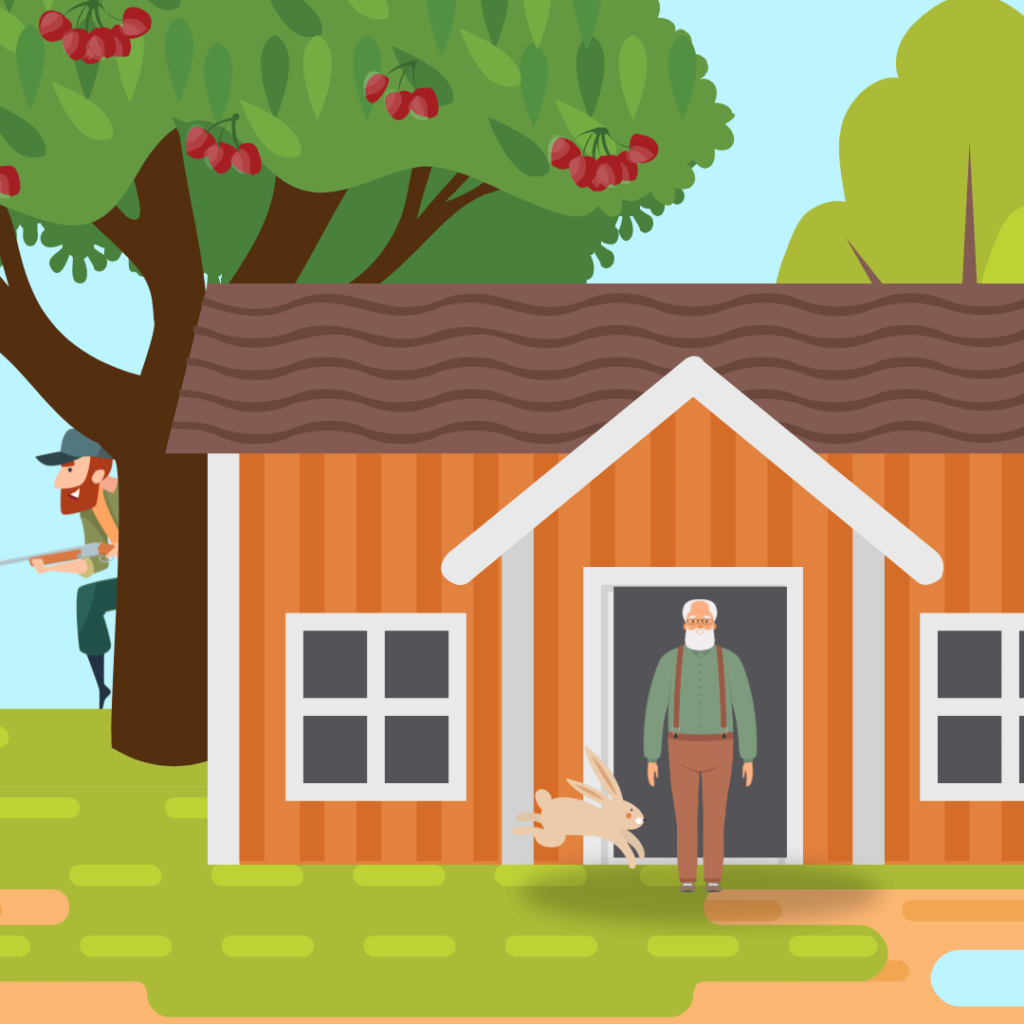
Incorporate the sign for “help” into songs or rhymes about helping or teamwork.
Recommended Song: “In a cottage in a Wood”
Lyrics with Sign: “In a cottage in a wood, A little man at the window stood, Saw a rabbit running by, Knocking at the door. “Help me, help me, help me,” he said, “Before the hunter shoots me dead!”, “Come little rabbit, come with me, Oh how happy we will be!””
During song time, you can extend the use of the key word sign “help” beyond just using the word in the song, you can also effectively use the sign for “help” to create an engaging and interactive environment. Here are some practical examples of how to incorporate the concept of “help” into your song sessions:
- Getting Ready for Song Time: As children gather for song time, you might say, “Can you help get ready by sitting on the mat?” This sets a collaborative tone right from the start.
- Organising Props: If you’re using instruments or props, encourage participation by asking, “Can you help me pass out the shakers?”
- Choosing a Song: When it’s time to pick a song, prompt the children with, “Who can help me choose our next song?”
- Encouraging Participation: Throughout the session, remind them to ask for help if they need it: “If you need help with the actions, just hold your hands up high!”
- Wrap-Up: At the end of song time, you could say, “Can you help me put everything back in the basket?”
By using the sign for “help” in these contexts, you create a supportive atmosphere that encourages children to express their needs and work together. This reinforces the concept of helping and builds their communication skills while making the song time experience more interactive and enjoyable.
Play
During cooperative games or role-play scenarios, encourage your child to sign “help” when they need assistance.
Examples:
- “Can you help your friend build the block tower?”
- “The teddy bear is stuck. Can you help rescue him?”
- “In our pretend hospital, the doctors and nurses help people feel better.”
10. Stop
Please click on the images for pop up tutorials of the key word signs.
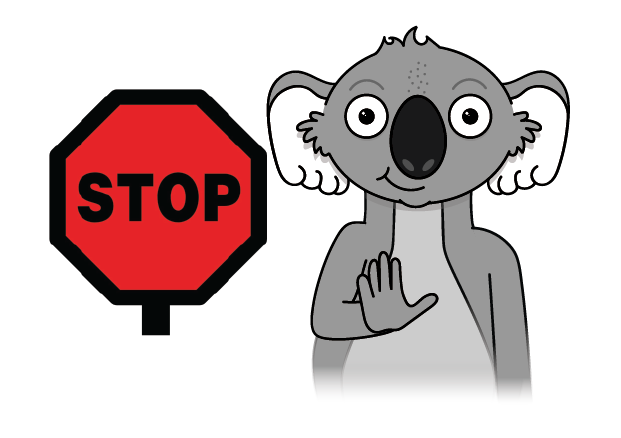
Routine
Use the sign for “stop” to signal the end of an activity or to establish boundaries.
Examples:
- “Let’s stop playing and get ready for bed.”
- “Stop running inside the house, please.”
- “When the timer rings, it means stop colouring.”
Book
Choose books that involve characters stopping an action and use the sign when appropriate.
Recommended Book: Go! Go! Go! Stop! by Charise Mericle Harper
Example:
- “It was the perfect amount of go and stop to get things done.”
Song – Nursery Rhyme
Incorporate the sign for “stop” into songs or rhymes, especially those involving movement.
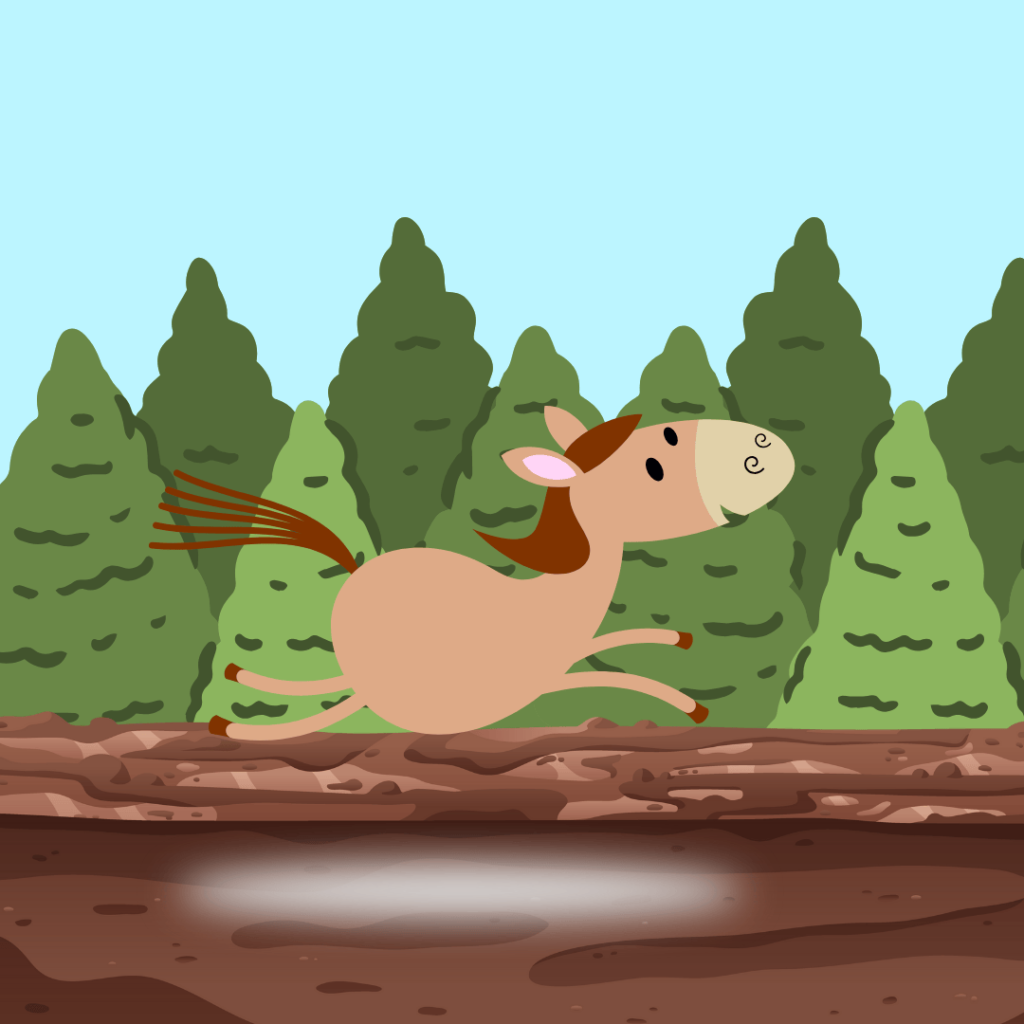
Recommended Song: “Horsey, Horsey”
Lyrics with Sign: “Horsey, Horsey don’t you stop, just let your feet go clippety-clop. Your tail goes swish, and the wheels go round, giddy up we’re homeward bound.”
Recommended Song: “The Traffic Light Song” (to the tune of “Twinkle, Twinkle, Little Star”)
Lyrics with Sign: “Red light, red light, what do you say? I say stop and stay away. Yellow light, yellow light, what do you mean? I say wait, till the light turns green. Green light, green light, what do you say? I say go, but look both ways!”
During song time, you can effectively incorporate the sign for “stop” to create a dynamic and engaging atmosphere. Here are some practical ways to do this:
Getting Ready for Song Time: As children gather for song time, say, “Before we start, let’s all stop talking and focus on our song!” This sets a collaborative tone right from the beginning.
During the Song: While singing, you can use the sign for “stop” to create pauses for emphasis. For instance, when you reach the part about clapping, you can say, “Now, let’s clap our hands! But when I say stop, you have to freeze!” This encourages children to be attentive and responsive to your cues.
Encouraging Participation: Prompt the children with, “If you need to stop because you’re feeling tired or need a break, just let me know!” This reinforces the importance of listening to their bodies and recognizing when to pause.
Interactive Questions: After singing, engage the children by asking, “What other actions do we need tostop for? Can you think of times when we need to [sign] stop playing or running?” This encourages critical thinking about the concept of stopping in various situations.
Wrap-Up: As song time comes to an end, you could say, “Now it’s time to stop and help me clean up. Let’s put away our props!” This not only reinforces the sign but also transitions smoothly to the next activity.
By incorporating the sign for “stop” throughout your song sessions, you create a more interactive and enjoyable experience for the children. This approach not only reinforces language skills but also helps them understand the concept of stopping in a fun and engaging way.
Play
Stop is such a vital word, here are some games and activities you could do to aid a child’s understand of the key word sign for stop.
- Musical Statues (Freeze Dance)
In this classic game, children dance to music and must freeze when the music stops. - Traffic Light Game
Set up a play area where one child acts as the traffic light.- Gameplay: The traffic light calls out “green light” to signal “go” and “red light” to signal “stop.” Children move on green and freeze on red.
- Incorporation of Signs: When the traffic light says “red light,” they should sign “stop,” reinforcing the connection between the sign and the action of stopping.
- Obstacle Course
Create a simple obstacle course with various challenges.- Gameplay: Children navigate the course, running, jumping, and crawling through different obstacles.
- Incorporation of Signs: Throughout the course, use moments to call out “[sign] stop!” to signal them to pause at specific checkpoints, helping them practice the concept of stopping.
- Follow the Leader
One child takes the lead, performing actions that others must mimic.- Gameplay: The leader can include movements that involve starting and stopping, like “Jump, then [sign] stop!”
- Incorporation of Signs: When the leader says “[sign] stop,” everyone must freeze, reinforcing their understanding of the word.
- Simon Says
Play Simon Says with a focus on actions that include both go and stop.- Gameplay: Give commands that require children to start and stop, such as “Simon says jump, then [sign] stop!”
- Incorporation of Signs: This not only reinforces the sign for “stop” but also helps them practice listening skills and following directions.
- Red Light, Green Light
This game involves one child calling out “green light” for everyone to move and “red light” for them to stop.- Gameplay: Children move toward the caller on “green light” and must freeze on “red light.”
- Incorporation of Signs: When “red light” is called, everyone should sign “stop,” emphasizing the action of freezing in place.
- Gameplay: When the music plays, they move around freely. Once the music stops, they must freeze in place.
• Incorporation of Signs: Encourage children to use the sign for “stop” when the music halts. You might say, “When the music stops, freeze like a statue!” This reinforces the meaning of stopping in a fun context.
11. Wait

Routine
Use the sign for “wait” during daily activities to help your child learn patience and turn-taking.
Examples:
- “Wait for your turn on the slide.”
- “Wait a moment while I get your snack ready.”
- “Please wait until everyone is seated before we start eating.”
Book
Incorporate the sign for “wait” when reading stories, especially those that involve anticipation or delayed gratification.
Recommended Book: “Waiting Is Not Easy!” by Mo Willems
Example:
- “Wait? What? Why?”
You could also use the term wait while reading a book to encourage the use of sign and its usage of different context. You could use the key word sign “Wait” during Book Reading Activities in the following ways:
Comprehension Checks: At the end of a chapter or section, use the “wait” sign and say, “Before we move on, let’s wait and remember what we’ve read so far.”
Page Turning: Before turning the page, use the “wait” sign and say, “Let’s wait a moment before we see what happens next. What do you think will happen?”
Picture Exploration: When there’s a detailed illustration, say, “Wait, let’s look closely at this picture. Can you find the hidden object?”
Predicting Outcomes: At a crucial point in the story, use the “wait” sign and ask, “What do you think the character will do? Wait, let’s think about it before we read on.”
Vocabulary Building: When encountering a new word, say, “Wait, let’s talk about what this word means before we continue.”
Emotional Responses: If a character is facing a challenge, use the “wait” sign and say, “How do you think the character feels? Let’s wait and discuss before we see what they do.”
Interactive Elements: For books with flaps or interactive elements, say, “Wait to open the flap until we’ve tried to guess what’s underneath.”
Connecting to Personal Experiences: Pause during reading and say, “Wait, does this remind you of anything that has happened to you?”
Song – Nursery Rhyme
Include the sign for “wait” in songs or rhymes that involve anticipation or pauses.
Recommended Song: “The Itsy Bitsy Spider”
Lyrics with Sign:
“Mary had a little lamb,
little lamb, little lamb,
Mary had a little lamb, its fleece was white as snow.
And everywhere that Mary went,
Mary went, Mary went,
and everywhere that Mary went, the lamb was sure to go.
It followed her to school one day school one day, school one day,
It followed her to school one day, which was against the rules.
It made the children laugh and play, laugh and play, laugh and play,
it made the children laugh and play to see
a lamb at school.
And so the teacher turned it out,
turned it out, turned it out,
And so the teacher turned it out, but still it lingered near,
And waited patiently about,
patiently about, patiently about,
And waited patiently about till Mary did appear.
“Why does the lamb love Mary so?” Love Mary so? Love Mary so?
“Why does the lamb love Mary so,” the eager children cry.
“Why, Mary loves the lamb, you know.”
The lamb, you know, the lamb, you know,
“Why, Mary loves the lamb, you know,” the teacher did reply.
Additional Ideas:
- Create a game where children must “wait” for a cue before singing the next line.
- Use the “wait” sign during repetitive parts of the song, building anticipation.
- Discuss other situations where we might need to wait patiently, like the lamb in the song.
This approach helps children understand the concept of waiting in a fun, musical context, reinforcing both the sign and the idea of patience.
Play
During play, use the sign for “wait” to teach turn-taking, patience, and anticipation.
Examples:
- Board games: “It’s not your turn yet. Wait until the dice shows a six!”
- Hide and seek: “Wait here and count to ten before you start looking!”
- Baking: “We need to wait for the cookies to cool before we can eat them.”
By using the sign for “wait” during these moments, you help children develop impulse control and understand the concept of delayed gratification. This is crucial for social development and emotional regulation.
Further examples:
- “Wait for the paint to dry before we add another colour.”
- “Let’s wait and see what happens when we add this to the water.”
- “Wait for your friend to finish speaking before you share your idea.”
12. Toilet
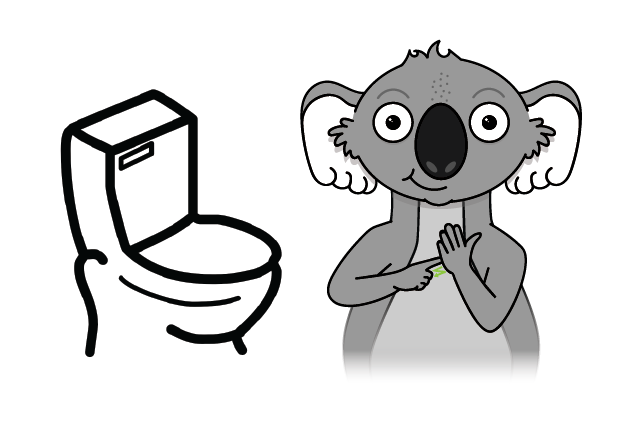
Routine
Use the sign for “toilet” during daily routines to help your child communicate their needs.
Examples:
- “Do you need to use the toilet before we leave?”
- “Let’s go to the toilet before bedtime.”
- “Remember to flush the toilet when you’re done.”
Book
Recommended Book: There’s a Big Green Frog in the Toilet by Anh Do
Example: “There’s a big green frog in the toilet and it’s looking up and me.”
Use the key word sign for “toilet” when reading this funny book about an unexpected toilet visitor. The humour can help make the topic of toilets more engaging and less intimidating for children. As well as signing toilet when reading it in the text you could also use it in the following ways:
Examples:
- “Oh no! There’s a frog in the toilet! Can you show me the sign for toilet?”
- “The boy wants to use the toilet, but the frog is in the way!”
- “Let’s count how many times we see a toilet in this book. Remember to use the sign each time!”
You can make this book experience even more interactive by:
- Asking the child to do the sign for “toilet” every time they see one in the book’s illustrations.
- Encouraging them to make frog sounds or pretend to be the frog when it’s hopping around the bathroom.
- Discussing what they would do if they found a frog in their toilet at home.
This funny story can spark conversations about using the toilet while keeping the mood light and entertaining. It’s a great way to combine humour with learning, making the concept of toilets less daunting and more approachable for children.
Song – Nursery Rhyme
Recommended Song: “The Toilet Song” by The Wiggles (found on YouTube)
Lyrics: Can you take the toilet challenge?
Can you sit on the toilet for this whole song?
And at the end, you can press the button to flush
How does that sound?
First, are you sitting on the toilet?
Oh, great
Are you ready?
Okay, here we go
Are you sitting on the toilet?
See what you can do
Now you’re sitting on the toilet
You can do a wee or a poo
Now try it
Do you feel it coming?
Any luck?
(Oh) that’s okay
Let’s try it again
We’re halfway through the toilet challenge
You’re like a prince or a princess on a throne
Can you feel anything coming soon?
Good luck!
Okay, let’s try it again
Are you ready?
Here we go
When you sit on the toilet
Like a prince or a princess on their throne
When you sit on the toilet
You can do a wee or a poo on your own
you did it!
You sat there for the whole song
And now, it’s clean up time
Now you can press the button and flush the toilet
After the count of three
Are you ready?
One, two, three
Flush!
Yippee!
While singing, you can emphasize the sign for “toilet” each time it appears in the lyrics. This repetition helps reinforce the sign and its meaning in a fun, musical context. You can also incorporate simple gestures or movements to match other parts of the song, like miming taking toilet paper or washing hands, to make it more engaging and help children remember the steps of using the toilet.
Play
Incorporate the sign for “toilet” into play activities to reinforce the concept and make it fun.
- Doll play: Use dolls or stuffed animals to practice toilet routines. “Oh, Teddy needs to use the toilet. Can you show him where it is?”
- Pretend play: Set up a pretend bathroom area and practice the steps of using the toilet. “Let’s pretend it’s morning. Do you need to use the toilet after waking up?”
- Storytelling: Create simple stories about characters using the toilet, incorporating the sign. This can help normalise the process and make it more engaging.
- “I Spy” bathroom edition: Play a modified version of “I Spy” in the bathroom, using the sign for “toilet” and other bathroom-related items. This can help familiarise children with the bathroom environment in a fun way
These play activities focus on making the concept of using the toilet familiar, fun, and part of everyday life without relying on external rewards. They aim to nurture a child’s natural curiosity and desire to learn and grow.
13. Sorry
Please click on the images for pop up tutorials of the key word signs.
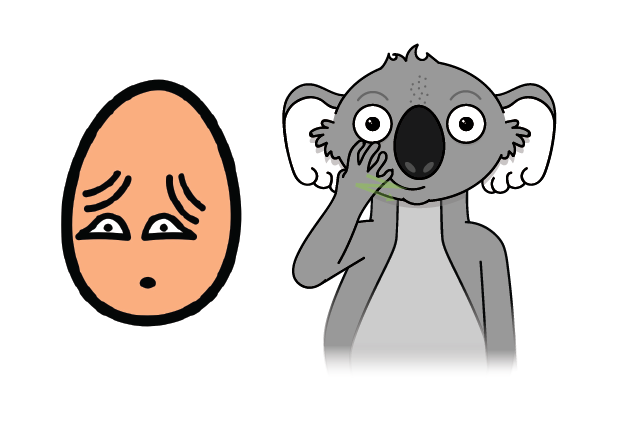
Routine
Teach your child how to apologise by modelling the sign for “sorry” in everyday situations. When parents demonstrate this behaviour, it helps instil the value of taking responsibility and showing empathy. Children learn by observing, and seeing an adult acknowledge their mistakes sets a powerful example for them.
Examples:
- “Mummy is sorry for forgetting to pack your favourite snack today.”
- “Can you see how Mummy is sorry for accidentally bumping into you? It helps us feel better and move on.”
- “Sometimes friends disagree. When Mummy says sorry for raising her voice, it shows that I have acknowledged the other person’s feelings.”
By consistently modelling the sign for “sorry,” you provide your child with a practical tool for expressing remorse and encourage them to recognise the significance of empathy and accountability in their interactions. This approach fosters their emotional development and helps them navigate social situations with greater awareness and kindness.
Book
Choose books that explore the concept of apologising and use the sign for “sorry” when appropriate.
Recommended Book: “I’m Sorry” by Barry Timms
Example:
- “”You’re not sorry at all,” replied Swoop.”
Song- Nursery Rhyme
Use songs or rhymes that incorporate saying sorry and include the sign.
Recommended Song: “The Sorry Song” (to the tune of “London Bridge is Falling Down”)
Lyrics with Sign: “When I’ve done something wrong, Something wrong, something wrong, When I’ve done something wrong, I say sorry.
Sorry helps to make things right, Make things right, make things right, [Sign] Sorry helps to make things right, It’s good to say sorry.“
Play
During pretend play or role-playing scenarios, model the use of “sorry” to help children understand its importance in social interactions.
Examples:
- “Oh no! The doctor accidentally gave the teddy bear the wrong medicine. The doctor says sorry?”
- “In our restaurant, if a waiter spills a drink, they should say sorry to the customer.”
- “Oh no the doll won’t share the dress with her friend, and now her friend has fallen over after letting go of the dress. Look the doll is saying sorry to her friend?”
14. Love
Please click on the images for pop up tutorials of the key word signs.
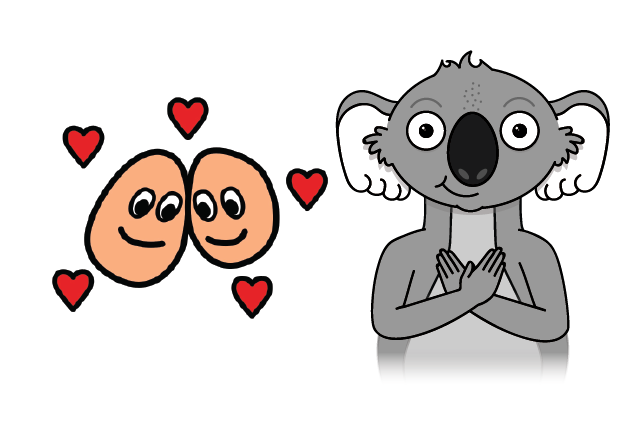
Routine
Use the sign for “love” during bonding moments, such as cuddles, bedtime, or when expressing affection. This reinforces emotional connections and helps children express their feelings.
Examples:
- “I love you so much. Sweet dreams!”
- “Grandma and Grandpa love you. They have their arms out do you want to give them a hug!”
- “Do you love playing in the park? It’s so much fun!”
Book
When reading books about love, family, or friendship, use the sign for “love” to make storytime even more heartwarming.
Recommended Book: “Guess How Much I Love You” by Sam McBratney
Example:
- “Little Nutbrown Hare, who was going to bed, held on tight to Big Nutbrown Hare’s very long ears. He wanted to be sure that Big Nutbrown Hare was listening. ‘Guess how much I love you,’ he said.”
Song – Nursery Rhyme
Incorporate the sign for “love” into songs or rhymes about affection and caring.
Recommended Song: “Skinnamarink” (also known as “Skidamarink”)
Lyrics with Sign: “Skinnamarink-a-dink-a-dink, Skinnamarink-a-doo, I love you.
Skinnamarink-a-dink-a-dink, Skinnamarink-a-doo, I love you, I love you, I love you in the morning, And in the afternoon, I love you in the evening, And underneath the moon. Oh, Skinnamarink-a-dink-a-dink, Skinnamarink-a-doo, I love you!”
Play
Modeling the sign for “love” during play helps your child understand and express affection in everyday situations. Here are some examples of how to incorporate this sign into your interactions:
- While playing with blocks, you might say:
“I love the colour blue. It’s my favourite!” - When creating art together, you could express your feelings by saying:
“Look at my drawing! I love how bright it is!” - During a pretend cooking session, you can share your enjoyment:
“I love making cookies with you. They smell so good!” - In a role play scenario, after a fun game of dress-up, you can show affection by saying:
“I love you! Let’s have a tea party together!”
By modelling the sign for “love” in these contexts, you provide your child with a clear example of how to express their feelings, reinforcing the meaning of the sign and enhancing their emotional and communicative development.
Conclusion
Incorporating these 12 key word signs into your daily routines, storytimes, songs, and play activities can significantly enhance your child’s communication skills and emotional development. Remember, consistency is key – the more you use these signs in various contexts, the more familiar and natural they’ll become for your child.
As you integrate key word signing into your interactions, you’ll likely notice improvements in your child’s ability to express themselves, understand others, and connect emotionally. This can lead to reduced frustration, increased confidence, and a stronger bond between you and your child.
Keep in mind that every child develops at their own pace, so be patient and celebrate each small success along the way. With time and practice, key word signing can become a valuable tool in your family’s communication toolbox, enriching your interactions and supporting your child’s overall development.
We hope this comprehensive guide has provided you with plenty of ideas and inspiration for using key word signs in your daily life. Happy signing!
For more information on getting started with key word sign please click here.

